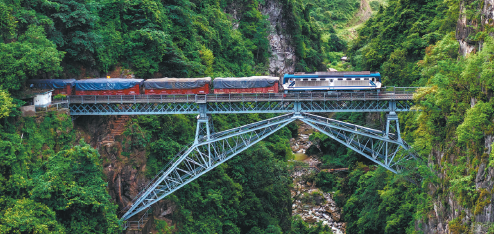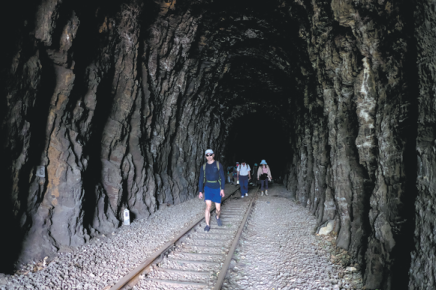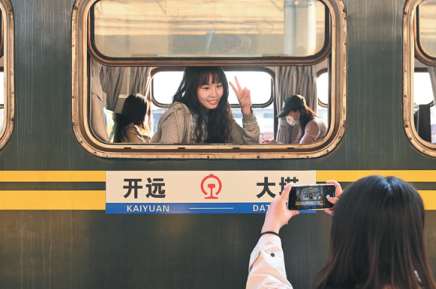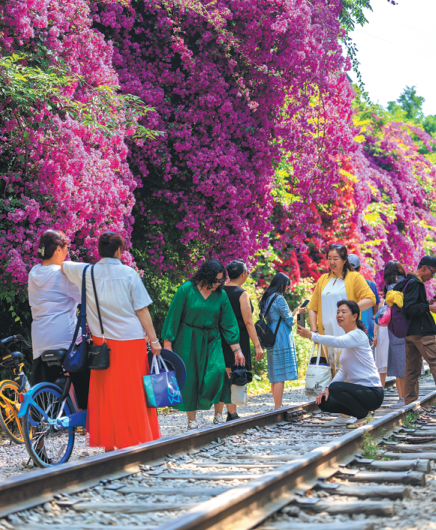A journey through the tracks of time
Known as an engineering marvel, a century-old railway in Yunnan province now attracts scores of visitors interested in its history, colonial architecture

On a hilltop in Yunnan province, campers can frequently hear the whistles and humming of train engines, as trains slowly make their way through the mountainous terrain on the narrow-gauge tracks.
The trains still run on the tracks of the Yunnan-Vietnam Railway, which was built over 114 years ago. There is no other railway like this, as it is the only 1-meter-gauge railway still in operation in the Chinese mainland. Described as a wonder of the Industrial Age, an increasing number of visitors have been drawn to the railway's history and many want to embark on the journey through time by hiking along the mustard-colored French-style stations.
The 854-kilometer-long Yunnan-Vietnam Railway connects Yunnan's capital Kunming with Vietnam's port city Haiphong. Backed by French capital and technology, construction of the Chinese part of the railway measuring 465 km started in October 1903 to facilitate France's colonial trade. But due to numerous difficulties in the project, many Chinese workers lost their lives.
After it began operations on March 31, 1910, The Times, a newspaper in the United Kingdom, named it one of the "Three Engineering Marvels of the World", along with the Suez Canal and Panama Canal.
In February 1958, the Chinese section of the railway was named the Kunming-Hekou Railway. To this day, it still conducts freight services between China and Vietnam daily.
According to records kept by foreign engineers, Yunnan's high mountains and deep valleys posed huge problems for the railway's constructors. On the Chinese section of the Yunnan-Vietnam Railway, there are 274.4 km of curves, accounting for 59.1 percent of its total length. Also, 75 bridges, 155 tunnels and 3,247 culverts were built along the railway with an elevation discrepancy of 1,954 meters.
Although passenger services were ceased in 2003, passenger experience of the train ride has lived on. Locals remember the S-shaped railway, rolling trains, bold drivers and brave travelers.
The most famous and must-see engineering marvel of the railway is the Wujiazhai Railway Bridge, commonly referred to as renziqiao for its unique arch design that looks like the Chinese character for people, or ren.
The bridge, located in Pingbian Miao autonomous county in Honghe Hani and Yi autonomous prefecture, straddles a gorge in between two mountains. As daily train services are very limited and not fixed, tourists are considered lucky if they are able to see the train come out from a tunnel passing the bridge 102 meters above the roaring Sicha River.
Tourists can hike up to the bridge in 45 minutes and can walk on the bridge to see it up close. To get to the bridge, tourists need to walk through a tunnel after reaching the railway tracks. They are able to see tool marks on the insides of the tunnel, evidence that it was dug out manually and a reminder of the hardships that the workers had to endure during its construction.
After seeing light at the end of the tunnel, the legendary Wujiazhai Railway Bridge will be within sight, reliable and charming as ever more than a century later. Visitors can then gather on viewing platforms on the bridge to admire the beauty of the bridge and watch the train pass by.
To build the 67.15-meter-long bridge connecting the extremely steep cliffs, French engineer Paul Bodin developed a new technique involving lowering two steel triangular trusses, one from each side of the mountain supported by ball-shaped seats of cast steel.
The construction project started in March 1907 and all parts of the bridge were shipped from France and assembled by Chinese workers. An estimated 800 Chinese workers lost their lives during the construction. A French newspaper commented at the time that the construction of the bridge was a "dance above death".
Comparing past and present
As many pictures and details of the railway's construction have been kept by members of the foreign construction team, many visitors choose to visit the places where the old pictures were taken to see how things have changed.
People can hike to the spot where the cliff above the railway was carved in the shape of the mouth of a roaring tiger, making just enough space for the train to go through.
They can also walk along the railway to reach a waterfall that still flows over the side of the mountain next to the railway track, forming the same stunning view combining the beauty of nature and engineering as captured in photos more than a century ago.
Also, spotting steel sleepers shipped from Europe that are still in use is a surreal and unique experience for travelers hiking along the railway.
Visitors are still able to spot the manufacturers of the railway track from the faded trademarks on the sleepers, such as German company Bochumer Verein Verkehrstechnik that has been manufacturing railway components since the invention of the railway system in Europe.
Moreover, the French-style stations along the railway have become a hit on Chinese social media, especially after the 2017 Chinese movie Youth was filmed at the stations, including Zhicun and Bisezhai in Mengzi city, capital of Honghe. They are among 34 stations that were put to use when the Chinese section of the Yunnan-Vietnam Railway was open to traffic in 1910.
The ending scene of Youth was shot at the platform of Zhicun station, which is still in use. The station has been well preserved with its original features intact, such as the mustard-colored walls and arched doors.
In a century of railway operations, several changes took place, including increasing or decreasing the number of stations, to meet the needs of freight transport and passenger services.
Nine small additional stations were built in 1922 due to increasing needs for transport volume. In the late 1950s and early 1960s, seven more stations were built to expand transport capacity. A total of 62 stations have been used over time.
Close connection
The lives of locals have been closely connected to the fate of the railway. For a long time, the railway was the only means of transportation for locals to commute in the mountains. But passenger services stopped in 2003 after new transportation infrastructure such as roads and modern railways became available in Honghe, resulting in the sharp drop in the number of people using the narrow-gauge train service, which is much slower. Thus, the glory days of the railway were gone. Many stations had been closed, leaving only 17 still in use.
While freight trains still stop at Zhicun station for services, all operations at Bisezhai station, which was once a vital stop on the Yunnan-Vietnam Railway, ceased in 2010. It has now become a tourist site dubbed "a piece of Paris of the East".
People can walk on the station platform adorned with louvered windows and imported Paul Garnier clocks. One of the century-old water towers, which was essential to the steam locomotives that needed water and coal to function, still stands next to the main entrance of the station.
Also, iconic buildings at the train station have been well preserved, including the customs building, post office, canteen and engineering offices.
Surprisingly, it even has China's first clay tennis court. The facilities were a reminder of how busy and important the station once was.
In 1940, to prevent Japan's invasion of China via the railway, the railway track between Bisezhai station and Hekou station was deliberately destroyed. The Chinese government later restored the track after taking over operations of the railway in 1950.
People can learn more about the history of the Yunnan-Vietnam Railway at the Yunnan Railway Museum built on the old Kunming North Station, the terminus of the railway. The French-style building is right next to the new and futuristic Kunming North Station offering people high-speed rail services, a representation of history meeting modernity.
Many relics of the iconic railway are on display at the museum, such as tools used for surveying and pictures of the construction. Among them, the white Michelin railcar that was put to use in 1914 offering luxury services to distinguished guests is definitely one of the main attractions.
Back then, many goods including machinery parts could be shipped to Kunming because of the railway. With the imported engines, Shilongba Hydropower Station — the first hydropower station in China — started to provide electricity to Kunming in 1912. Also, a water pump station, built in the city with parts and materials shipped via the railway, started to supply water in May 1918, making Kunming locals the first in China to enjoy running water.
More than 114 years on, goods are still shipped between Yunnan to Vietnam via the same railway. According to the China Railway Kunming Bureau, more than 168,500 metric tons of goods, including iron ore and sulfur, have been transported via the narrow-gauge railway during the first four months this year, an increase of over 1.5 times year-on-year.
The Chinese section of the Yunnan-Vietnam Railway has seen many ups and downs, standing the test of time through war and turmoil. Although the construction of the railway initially fueled France's ambitions for colonial expansion, it is also an engineering marvel, casting its profound impact on the locals and the land up till today. As for visitors, discovering the stories behind the railway is just as fascinating as following its tracks running through the beautiful terrain in Yunnan.




Today's Top News
- Israel's Gaza takeover plan widely condemned
- S. Korea visa waiver spurs surge in travel interest
- Top cities signal easing to support property market
- Ties bolster heritage protection
- Gaza 'takeover' will ignite another horrific chapter for the Middle East: China Daily editorial
- STAR shines for innovative companies






























